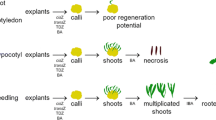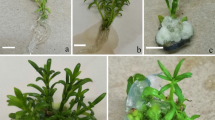Abstract
The inflorescences as explants for rapid propagation in vitro remained unknown in Populus euphratica Olivier. Here, we reported that multiple shoots were initiation from calli of both male and female inflorescences. The optimum medium for shoot induction from male inflorescences was lactose sulfite medium containing 1.0 mg L−1 6-benzylaminopurine (BA) and 0.5 mg L−1 α-naphthalene acetic acid (NAA) or Murashige and Skoog (MS) medium containing 0.5 mg L−1 BA and 0.2 mg L−1 NAA. The optimum medium of shoot induction from female inflorescence calli was the MS medium containing 0.5 mg L−1 BA and 0.2 mg L−1 NAA. Rooting of regenerated shoots was obtained on 1/2 MS medium supplemented with 0.5∼1.0 mg L−1 indole-3-butyric acid (IBA) and the highest frequency rooting was on medium containing 0.5 mg L−1 IBA. No shoots were obtained on medium without BA and NAA. Peroxidase (POD) activity was measured by polyacrylamide gel electrophoresis during shoot induction and differentiation stages. The results showed that two bands of POD (2a and 2b) activity appeared lowest during the early 8 days at the dedifferentiation phase of leaves inducing calli, whereas POD 2a, 2b activity appeared to be increasing at the homeochronous dedifferentiation phase of inflorescence. Five most intensive bands, POD 1a, 1b, 1c, 2a, and ab, appeared in 8th and 28th days at the redifferentiation phase during shoot morphogenesis. These results demonstrated that the POD was involved in shoot morphogenesis from both leaf and inflorescence explants of Populus euphratica.



Similar content being viewed by others
References
Ferreira, S., Hjernø, K., Larsen, M., Wingsle, G., Larsen, P., Fey, S., et al. (2006). Proteome profiling of Populus euphratica Oliv. upon heat stress. Annual Botany (London), 98, 361–377.
Hukin, D., Cochard, H., Dreyer, E., Le Thiec, D., & Bogeat Triboulot, M. B. (2005). Cavitation vulnerability in roots and shoots: does Populus euphratica Oliv., a poplar from arid areas of Central Asia, differ from other poplar species? Journal of Experimental Botany, 56, 2003–2010.
Wu, Y., Ding, N., Zhao, X., Zhao, M., Chang, Z., Liu, J., et al. (2007). Molecular characterization of PeSOS1: the putative Na+/H+ antiporter of Populus euphratica. Plant Molecular Biology, 65, 1–11.
Bruelheide, H., Jandt, U., Gries, D., Thomas, F., Foetzki, A., Buerkert, A., et al. (2003). Vegetation changes in a river oasis on the southern rim of the Taklamakan Desert in China between 1956 and 2000. Phytocoenologia, 33, 801–818.
Wang, S. (1996). The status, conservation and recovery of globe resources of Populus euphratica. World Forest Research, 6, 37–43.
Cheong, E., & Moon, H. K. (1999). Effect of light, cytokines and explant’s position on adventitious bud induction from the leaf segments of P. euphratica. Journal of Forest Science (Seoul), 62, 92–98.
Ding, X., Chen, X., & Li, W. (2006). Effect of antibiotics on plantlet regeneration via organogenesis in Populus euphratica. Forestry Studies in China, 8, 27–31.
Gu, R., Liu, Q., Pei, D., & Jiang, X. (2004). Understanding saline and osmotic tolerance of Populus euphratica suspended cells. Plant Cell Tissue and Organ Cultural, 78, 261–265.
Liedo, M. D., Crespo, M. B., & Amomasco, J. B. (1995). The role of cytokinins and ethylene inhibitors on lenticel hypertrophy generation and ethylene production in vitro cultures of Populus euphratica Olivier. Israel Journal of Plant Sciences, 43, 339–345.
Rahimi, A., Emad, M., & Rezaian, G. (2008). Smoke from leaves of Populus euphratica Olivier vs. conventional cryotherapy for the treatment of cutaneous warts: a pilot, randomized, single-blind, prospective study. International Journal of Dermatology, 47, 393–397.
Watanabe, S., Kihuna, K., Ide, Y., et al. (1999). Establishment of a tissue culture system of Populus euphratica Oliv. Bulletin of the Tokyo University Forests, 102, 87–92.
Davies, T., & Haissig, B. (1994). Biology of adventitious root formation (pp. 275–280). New York: Plenum Press.
Asma, B. G., Gilbert, C., & Michel, B. (2008). Rapid shoot regeneration from thin cell layer explants excised from petioles and hypocotyls in four cultivars of Brassica napus L. Plant Cell Tissue and Organ Cultural, 92, 25–30.
Montiel, G., Breton, C., Thiersault, M., Burlat, V., Jay-Allemand, C., & Gantet, P. (2007). Transcription factor Agamous-like 12 from Arabidopsis promotes tissue-like organization and alkaloid biosynthesis in Catharanthus roseus suspension cells. Metabolic Engineering, 9, 125–132.
Sinnott, E. W. (1960). Plant morphogenesis. New York: McGraw-Hill.
Makunga, N. P., & Staden, J. V. (2008). An efficient system for the production of clonal plantlets of the medicinally important aromatic plant: Salvia africana-lutea L. Plant Cell Tissue and Organ Cultural, 92, 63–72.
Isaac, N., Maria, G., & Fredy, A. (2008). The effect of auxin type and cytokinin concentration on callus induction and plant regeneration frequency from immature inflorescence segments of seashore paspalum (Paspalum vaginatum Swartz). In Vitro Cellular and Developmental Biology—Plant, 44, 480–486.
Gruis, D., Guo, H., Selinger, D., Tian, Q., & Olsen, O. (2006). Surface position, not signaling from surrounding maternal tissues, specifies aleurone epidermal cell fate in maize. Plant Physiology, 141, 898–909.
Che, P., Lall, S., Nettleton, D., & Howell, S. (2006). Gene expression programs during shoot, root, and callus development in Arabidopsis tissue culture. Plant Physiology, 141, 620–637.
Lamport DTA., 1980. Structure and functions of plant glycoproteins. Biochemistry of plant, vol. 3. Academic Press, New York, p. 501
Wang, B., Wang, J., Zhao, H., & Zhao, H. (2006). Stress induced plant resistance and enzyme activity varying in cucumber. Colloids and Surfaces. B, Biointerfaces, 48, 138–142.
Arican, E., Albayrak, G., & Gozukirmizi, N. (2008). Calli cultures from Abies equi-trojani Aschers et Sinten and changes in antioxidant defense system enzymes. Journal Environment Biology, 29, 841–844.
Stefanos, P., Hatzilazarou, T. D. S., Traianos, A., Yupsanis, A. M., & Bosabalidis, A. S. (2006). Peroxidases, lignin and anatomy during in vitro and ex vitro rooting of gardenia (Gardenia jasminoides Ellis) microshoots. Journal of Plant Physiology, 163, 827–836.
Gu, R., Jiang, X., & Guo, Z. (1999). Organogenesis and plantlet regeneration in vitro of Populus euphratica. Acta Botanica Sinica, 41, 29–33.
Acknowledgments
We thank Zhu Xiaohu and Wang Xiaowei of Xinjiang Agriculture University for providing branches of P. euphratica and Jiang Hua of Xinjiang Agriculture University for occasionally participating in the research. This study was supported by the National Natural Science Foundation of China (project nos. 30671709 and 30460010), the National Engineering Laboratory for Tree Breeding, the Key Laboratory of Genetics and Breeding in Forest Trees and Ornamental Plants of the Ministry of Education, and the Tree and Ornamental Plant Breeding and Biotechnology Laboratory of the State Forestry Administration in China.
Author information
Authors and Affiliations
Corresponding author
Electronic supplementary material
Below is the link to the electronic supplementary material.
ESM 1
(DOC 803 kb)
Rights and permissions
About this article
Cite this article
Zhou, Y., Gao, Z., Gao, S. et al. In Vitro Adventitious Shoot Regeneration via Indirect Organogenesis from Inflorescence Explants and Peroxidase Involvement in Morphogenesis of Populus euphratica Olivier. Appl Biochem Biotechnol 168, 2067–2078 (2012). https://doi.org/10.1007/s12010-012-9918-y
Received:
Accepted:
Published:
Issue Date:
DOI: https://doi.org/10.1007/s12010-012-9918-y




